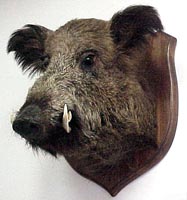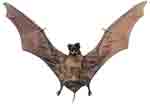Don't worry: it is neither contagious, nor a disease! As we have said for the Insects that it's possible to preserve the Invertebrates through suitable techniques of preparation, so also for the Vertebrata there's the taxidermy, better known like embalming or stuffing, between the natural preparation undoubtedly the most representative.
Excluding the possibility to embalm your mother-in-law, a criminal offense in Italy, or the mummies that we do not deal (you can turning to an egyptologist), we have mostly Birds, if necessary also Mammals or Reptiles.
Amphibians (mostly tropical frogs), bony fishes (eg. piranhas) and cartilaginous fishes (sharks and rays) you can find in the Other Animals Catalog.
The technique of preparation is completely different from that one adopted for the Arthropods and very much laborious; it often varies also between similar animals. Taxidermy is an ancient art, therefore please don't ask us to reveal the secrets of the trade; but we can reassure you because the toxic materials (eg. arsenic) used in the past century that often cause the untimely death of the poor taxidermist, today are not in use anymore, replaced by other substances. So don't be afraid unless unexpected happens, we would still to be here for a long time (...we hope so).
The animals in our catalogue are only some examples of Vertebrata that they can be prepared, and obviously don't exaust the innumerable varieties of species and postures with which the taxidermy tries to immortalize for ever the living beings. So there are the canary or the heron mounted on various pedestals, from turned traditional pedestal for collection to the small wooden board, from the artificial rock to the trunk of a tree, all embellished with moss, earth, gravel, etc. An analogous speech to the birds can be made for fish, reptiles, small or great mammals, and further preparations are those on wall shields like the classic head of deer, wild boar or big gallinacean, and diorama, like those in the museums, often of great dimensions, where the animals are mounted in a natural posture, the same that they have while were still alive in their habitats. Typical of the stuffing job are the hunting trophies with horn of Artiodactyls, tusks of wild boar, fish like pikes, etc.
A last superflous information: all the animals of our catalogue have been regularly denounced and in order with the laws in force (you can see also the F.A.Q.).
Like for every category, our catalogues are subject to frequent revision, so you often come back to visit us if you are searching for novelties.
And now...good safari!
-
Minerals & Gems
- Dropdown gift ideas
-
Dropdown crystaltherapy
- Dropdown lots kits and packaging
- Dropdown tumbled stones
- Dropdown worked points
- Dropdown masseurs sticks pebbles salts
- Dropdown pendulums or pendants
- Dropdown pyramids
- Dropdown spheres and eggs (ovos)
- Dropdown agata slices
- Dropdown figured stones
- Dropdown moqui abalone Apache tears shiva lingam
- Dropdown ornaments and gadgets
- Dropdown costume jewelry tumbled stones
- Dropdown jewels and worked gems
- Dropdown raw minerals, rocks and crystals
- Dropdown meteorites volcanoes
-
Insects
- Dropdown gift ideas
- Dropdown butterflies (Lepidoptera)
- Dropdown coleopters
- Dropdown arachnids
- Dropdown dragonflies
- Dropdown hymenopters
- Dropdown hemipterons
- Dropdown Diptera
- Dropdown orthopterians
- Dropdown other insects
- Dropdown italian palearctic insects
- Dropdown insects stocks
- Shells
- Sharks
- Other Items
-
Fossils
- Dropdown gift ideas books
- Dropdown reptiles and dinosaurs
- Dropdown mammals
- Dropdown fishes and sharks
- Dropdown amphibians and birds
- Dropdown ammonites and shells
- Dropdown trilobites and other invertebrates
- Dropdown ambers and vegetables
- Dropdown stone hand-made other
- Dropdown fossil stocks and in boxes
- Taxidermy
- Equipment





